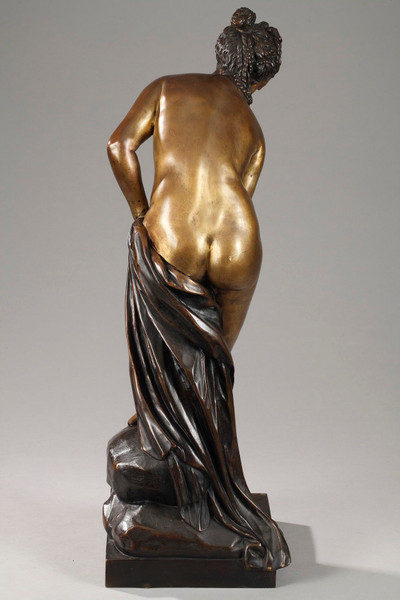Bronze sculpture with brown and gilded patina after "Venus emerging from the bath", also known as "La Baigneuse" by Gabriel-Christophe Allégrain (Paris, 1710-1795). The neoclassical marble original was commissioned in 1755 by the Marquis de Marigny (1727-1781), Director General of Bâtiments du Roi, for his Château de Choisy-le-Roi. The plaster model was presented at the Salon of 1757, and the marble statue at the Salon of 1767, where it was noticed by Denis Diderot, who famously commented: "Belle, belle, sublime figure; they even say the most beautiful, the most perfect figure that moderns have made [...] The beautiful shoulders, how beautiful they are, how chubby this back is, what a shape to the arms, what precious, miraculous truths of nature in all these parts". This was the sculptor's first major commission. Allegrain was significantly inspired by a small bronze by the Mannerist sculptor Jean de Bologne, "Baigneuse posant le pied sur un vase de parfum" (Bathress placing her foot on a vase of perfume), echoing the sinuous line of the body, the drooping shoulders, the high bosom and the hairstyle composed of sophisticated braids. The sculpture was acquired by Louis XV, who presented it on April 12, 1772 to his favorite, the Countess Du Barry (1743-1793), who installed it in the grounds of her Château de Louveciennes. The original is now in the Louvre Museum. This bronze edition was produced in the 19th century by the Parisian bronze-maker Graux-Marly Frères (engraved mark on the base: GRAUX-MARLY FRERES / PARIS). Graux-Marly, founded in 1845, was established at 8, rue du Parc Royal in 1862. It produced sculptures and furnishings. It won a bronze medal at the 1849 Exposition Nationale des Produits de l'Industrie and a first-class medal at the 1855 Exposition Universelle. The company was dissolved in May 1890.
- Reference :
- 1732
- Availability :
- Sold
- Width :
- 19 (cm)
- Height :
- 59 (cm)
- Depth :
- 20 (cm)
- Identifier Exists:
- False



















